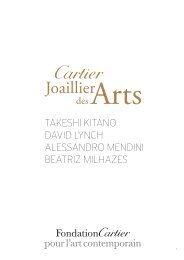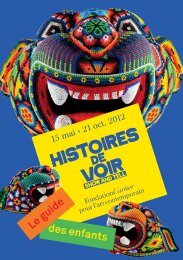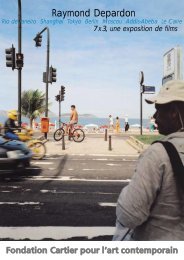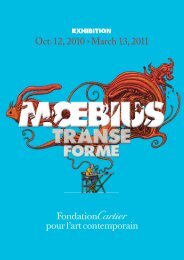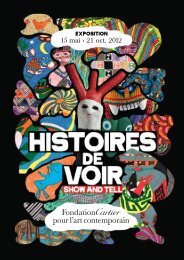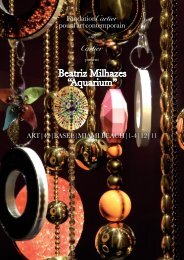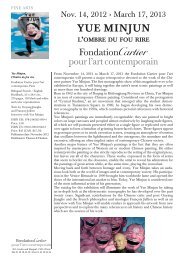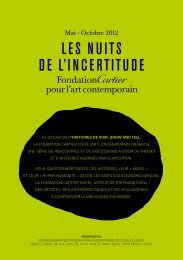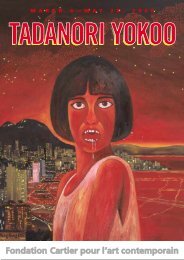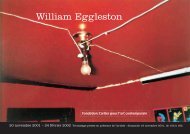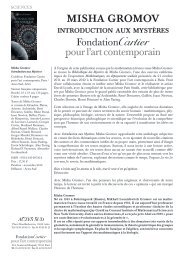OTHONIEL VERS PDF ANG - Fondation Cartier pour l'art ...
OTHONIEL VERS PDF ANG - Fondation Cartier pour l'art ...
OTHONIEL VERS PDF ANG - Fondation Cartier pour l'art ...
You also want an ePaper? Increase the reach of your titles
YUMPU automatically turns print PDFs into web optimized ePapers that Google loves.
Press release<br />
Press Opening on Thursday, October 30, 2003 at 3:00 pm<br />
The <strong>Fondation</strong> <strong>Cartier</strong> <strong>pour</strong> l’art contemporain<br />
presents Crystal Palace, a unique exhibition by Othoniel,<br />
from October 31, 2003 to January 11, 2004.<br />
After taking part in the artist’s workshops in Jouy-en-Josas (1989) and<br />
after participating in the Azur (1993) and Amours (1997) exhibitions,<br />
Othoniel is back with an original project entirely conceived as a pendant<br />
to Jean Nouvel’s glass building. In much the same spirit as his<br />
Kiosque des Noctambules (2000) which re-interpreted, after Hector<br />
Guimard, the entrance to the Palais-Royal subway station, he invites the<br />
public to take another walk, this time through the ground floor spaces<br />
and into the gardens of the <strong>Fondation</strong> <strong>Cartier</strong>.<br />
His interest in metamorphoses, sublimations, and<br />
transmutations led Jean-Michel Othoniel (born<br />
in 1964; lives in Paris) to privilege materials with<br />
reversible properties. His sculptures in sulfur, lead, wax or<br />
phosphorus attracted attention, and he rapidly emerged<br />
on the international scene, exhibiting in Paris, Tokyo, New<br />
York, Berlin… His sources of inspiration are minimalism<br />
and Arte povera, the artistic expressions of Broodthaers or<br />
Duchamp, and, in the literary field, Borges, Gracq, and<br />
Roussel. A special fascination—at once melancholic and<br />
scientific—for the major developments of the 19th century<br />
(photography, traveling, museums…), impelled him in<br />
the late ‘80s to embrace other forms of creativity, including<br />
sculpture, drawing, photography, writing, dance and<br />
video.<br />
In 1992 he was invited to show some of his sulfur<br />
sculptures in the Documenta in Kassel, Germany. In 1994<br />
he participated in the Féminin/Masculin exhibition at the<br />
Pompidou Center where he presented one of his major<br />
works, My Beautiful Closet.<br />
It was in 1993 that Othoniel irremediably introduced<br />
glass into his work. He began experimenting with its properties<br />
together with master glassmaker, Oscar Zanetti, in<br />
Murano. The artist molds the desired shapes in clay, and<br />
the master glassmaker then takes them and reproduces<br />
them along with their formal imperfections and irregularities.<br />
“Glass has a memory. If you injure a ball of melted<br />
glass by making an incision or any kind of cut into it, the<br />
glass will heal up. But once it cools, the wound will reappear.<br />
So Zanetti used these wounds to create some of the<br />
shapes I was looking for.”<br />
Blown-glass beads were thus made in Venice, as well as<br />
at the CIRVA—the International Glass Art Research Center<br />
founded in Marseille in 1986—and then fashioned into<br />
necklaces and enigmatic harnesses, a combination of jewelry,<br />
decoration and erotica.<br />
Transformation, transmutation of matter, rites of passage<br />
from one state to another, all of these reflect another rite<br />
which is fundamental to the artist’s work, that of traveling,<br />
with the memories brought back from gardens<br />
explored or secluded dwellings. In these spaces of ultimate<br />
freedom, open to reversibility and chance encounters,<br />
Othoniel sets up his glass creations for the fleeting<br />
pleasure of a temporary traveling companion—who is<br />
both a stranger and an accomplice. Thus, in 1996 his<br />
necklaces were suspended among the bamboo in the Villa<br />
Medicis gardens in Rome, then from the trees in the<br />
Venetian gardens of the Peggy Guggenheim Collection,<br />
and in 1999 in the Alhambra and the Generalife in<br />
Grenada. His pieces live, mingle with the old stones or<br />
the foliage, like so many organic excrescences that absorb<br />
Harnais, 1997<br />
Garden of the Peggy Guggenheim Collection, Venice<br />
Private collection, Paris<br />
Above left:<br />
Les amants suspendus, 1999<br />
Collection of the artist



